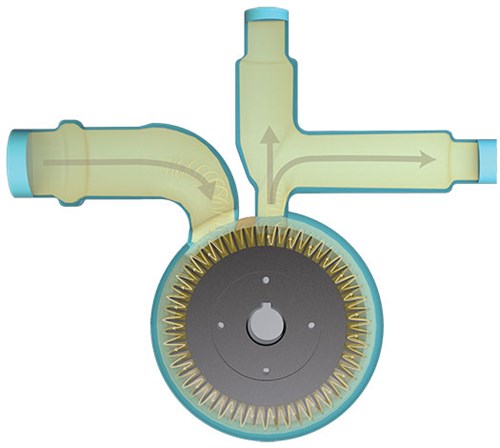Versatile and capable: Advantages of regenerative turbine pumps in LPG applications
Autogas (also referred to as LPG) has become a popular fuel source around the globe, evidenced by its steady increase in consumption in recent years. In 2019, global LPG consumption reached 27.1 MMt, with 27.8 MM LPG vehicles in use around the world, according to the World LPG Association.
This fuel source is a mixture of propane and butane. Its composition allows it to be stored and transported as a liquid and burned as a gas. With an abundance of LPG vehicles around the world, dispensing installations are needed to meet increasing demand.
However, LPG is not the easiest to handle or process. Pumps designed to handle LPG must be able to handle low viscosities—sometimes as low as 0.1 centipoise (10 times thinner than water)—and vapor pressure well above normal atmospheric pressure. Challenges arise under these conditions as many pumping technologies have trouble with slippage or keeping the substance contained.
Cavitation is another issue that comes with pumping volatile liquids. If the pump’s inlet pressure falls below the liquid’s vapor pressure, then vapor bubbles will form in the liquid. These bubbles will travel through the pumping chamber and, as the pressure increases, implode and cause cavitation, which can damage the pumping hardware.
Regenerative turbine pumps function as a superb solution to the demands of processing LPG. They can maintain high pressures while handling low-viscosities fluids and are not susceptible to cavitation damage.
This article will examine the capabilities of regenerative turbine pumps and why they work well vs. other pumping technologies when handling LPG and similar substances.
A closer look at regenerative turbine pumps. Though considered rotodynamic, regenerative turbine pumps have close parallels to positive displacement (PD) pumps. Regenerative turbine pumps provide multi-stage performance from a single-stage impeller designed to optimize performance. This enables the pump to create high differential pressures at low flowrates.
Regenerative turbine pumps function using a rotating, non-contact, free-wheeling impeller disc that has around 60 small cells on its periphery. When the liquid enters the suction port, the impeller obtains it and accelerates around the narrow hydraulic channel surrounding the cells. Kinetic energy carries the liquid rapidly around the channel. This motion within one revolution builds energy and pressure (FIG. 1).
 |
| FIG. 1. When liquid enters the suction port of the turbine pump, it is picked up by the impeller and instantly accelerated around in the narrow hydraulic channel (casing volute) surrounding the cells. The spiraling of the liquid at sonic speeds within the one revolution incrementally builds energy and pressure. |
The pump technology name stems from its function—the continuous regeneration of small liquid cells creates the differential pressure capability of the pump. Other names for this technology include peripheral pumps, centrifugal regenerative pumps and regenerative pumps, among many others. Regardless of the name, this technology is categorized in the rotodynamic family of pumps.
Regenerative turbine pumps have the versatility to transfer liquids at high pressure and low flow, while also processing entrained vapors or liquids at or near their boiling point. These conditions limit most pump technologies, causing performance issues, cavitation, vibration and noise. However, regenerative turbine pumps do not falter from those conditions.
Specifically, regenerative turbine pumps can handle viscosities of 0.1 centistokes (cSt)–50 cSt, with differential pressures up to 300 psi (20 bar) and a maximum allowable working pressure of up to 493 psi (34 bar) to enable handling liquids with high vapor pressures.
Typical regenerative turbine pumps generate flowrates up to 52.8 gpm (200 l/min), though some variations can operate with flowrates above that amount (FIG. 2). Some newer iterations of this technology can reach peak flowrates as high as—and potentially higher than—158.5 gpm (600 Ll/min).
 |
| FIG. 2. Typical regenerative turbine pumps generate flow rates up to 52.8 gpm (200 l/min), with some variations capable of even higher flow rates, such as 158.5 gpm (600 l/min). |
This pump technology thrives because of its design. The spiral motion, along with its speed, diminishes the chances for cavitation and pulsation by smoothing the fluid and collapsing the vapor bubbles immediately when they form. Vibration and noise problems also do not occur in most situations since the pump operates with a smooth flow and a hydraulically balanced design.
LPG is not the only application where regenerative turbine pumps excel. This technology functions optimally in applications known for having low-viscosity fluids, such as aerosols and refrigerants. Other applications include ammonia, vaporizer feed and cylinder filling, as well as boiler feedwater.
Matching up with side-channel pumps. Regenerative turbine pumps have similarities to PD pump technologies, such as side-channel pumps. One similarity is both pumps can self-prime and perform optimally under poor suction conditions. The differences come from the size of the pump and ease of maintenance.
Side-channel pumps are designed to have a larger footprint, primarily due to having multiple pumping stages. When considering an LPG installation, a side-channel pump might require 4–8 stages to meet the duty parameters. With that many stages, side-channel pumps and their large footprint become more complex to accommodate the installation’s demands.
Regenerative turbine pumps, which feature a single stage, can match the performance of the side-channel pump, while also functioning at two-pole speeds. Side-channel pumps typically operate at four-pole speeds.
With a larger size and more complexity, side-channel pumps require more components to properly function. More components mean more wear parts, all of which are prone to eventual failure. When that happens, those parts must be replaced, adding to the pump’s maintenance and total ownership cost.
Regenerative turbine pumps do not suffer from a large footprint or a complex design. Instead, regenerative turbine pumps have a compact footprint and up to 25 components, making it easier for operators to maintain over time. Spending less time on maintenance and components saves time and money. Also, the less-complex design means operators do not need a veteran engineer to maintain them, allowing any technically savvy associate with moderate experience to keep the technology running.
Stacking up with other PD pumps. Sliding vane pumps also match up well with regenerative turbine pumps and even have some advantages. The primary advantage comes from the technology having a higher hydraulic efficiency and better effectiveness during priming.
Despite regenerative turbine pumps not sharing these traits, they have others that make the technology effective in similar applications. Without as many moving parts as sliding vane pumps, regenerative turbine pumps can operate continuously without many drawbacks.
Operators do not have to worry about taking regenerative turbine pumps offline to replace wear parts on a frequent basis. Similar pump technologies have a variety of wear parts, each with different service and lifecycles. Without as many moving parts, operators of regenerative turbine pumps spend less time shutting down the pump for scheduled maintenance and do not have to stock as many components for eventual replacement.
Regenerative turbine pumps have two components subject to wear: the mechanical seal and (occasionally) the impeller. During scheduled maintenance, operators do not have to take them out of service. Regenerative turbine pumps have parts that can be replaced within an hour without removing the pump from the pipework or even disconnecting the motor.
Performance wise, regenerative turbine pumps can operate continuously without pulsation and cavitation. With the ability to operate continuously, engineers do not have to worry about frequent stops or the aforementioned detriments.
Takeaway. When it comes to challenging applications, especially those with poor suction conditions, low-viscosity liquids or fluids near their boiling point, operators have a wealth of pumping choices. However, if they want a technology with versatility at its core, regenerative turbine pumps stand out among the rest.
These pumps can handle a vast range of liquids under varying conditions in multiple applications. The common deterrents—cavitation, vibration and entrained vapor—that challenge most pumping technologies do not have the same effect on regenerative turbine pumps. Operators can expect longevity from this technology, as well as long intervals between maintenance.
When maintenance rolls around, less-experienced operators are as capable as veterans when servicing this technology. Operators are not required to replace several components or remove the pump for service for several hours. In most cases, the pumps can be repaired or rebuilt without removing them from the pipework.
The value of regenerative turbine pumps in LPG applications is clear: they have the versatility to process it optimally and effectively. As the technology continues to improve in the future, it will become a more common choice among operators in a wide range of applications. GP
 |
STEPHEN BASCLAIN is the Business Development Manager for Ebsray. Ebsray is a leader in the design and manufacture of regenerative turbine and positive DP technologies, including sliding vane, gear and lobe pumps.




Comments